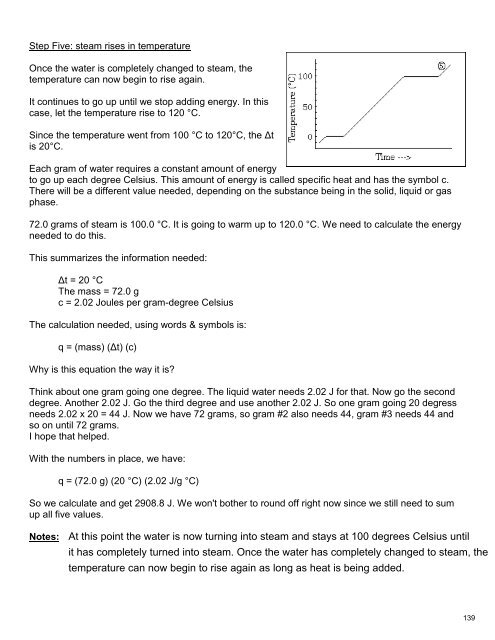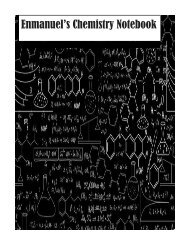You also want an ePaper? Increase the reach of your titles
YUMPU automatically turns print PDFs into web optimized ePapers that Google loves.
Step Five: steam rises in temperature<br />
Once the water is completely changed to steam, the<br />
temperature can now begin to rise again.<br />
It continues to go up until we stop adding energy. In this<br />
case, let the temperature rise to 120 °C.<br />
Since the temperature went from 100 °C to 120°C, the Δt<br />
is 20°C.<br />
Each gram of water requires a constant amount of energy<br />
to go up each degree Celsius. This amount of energy is called specific heat and has the symbol c.<br />
There will be a different value needed, depending on the substance being in the solid, liquid or gas<br />
phase.<br />
72.0 grams of steam is 100.0 °C. It is going to warm up to 120.0 °C. We need to calculate the energy<br />
needed to do this.<br />
This summarizes the information needed:<br />
Δt = 20 °C<br />
The mass = 72.0 g<br />
c = 2.02 Joules per gram-degree Celsius<br />
The calculation needed, using words & symbols is:<br />
q = (mass) (Δt) (c)<br />
Why is this equation the way it is?<br />
Think about one gram going one degree. The liquid water needs 2.02 J for that. Now go the second<br />
degree. Another 2.02 J. Go the third degree and use another 2.02 J. So one gram going 20 degress<br />
needs 2.02 x 20 = 44 J. Now we have 72 grams, so gram #2 also needs 44, gram #3 needs 44 and<br />
so on until 72 grams.<br />
I hope that helped.<br />
With the numbers in place, we have:<br />
q = (72.0 g) (20 °C) (2.02 J/g °C)<br />
So we calculate and get 2908.8 J. We won't bother to round off right now since we still need to sum<br />
up all five values.<br />
Notes:




